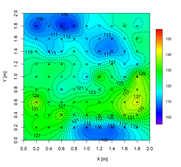Assesment of the Mechanical Variability of Rock Slabs by Means of Non-Destructive Tests: Analysis Methods
Main Article Content
Keywords
Geostatistics, signal model, mechanical variability, rock material, sodalite, Schmidt-L hammer
Abstract
In this paper is used more and complementary methods of analysis to estimate the mechanical variability of rock slabs by means of non-destructive tests; originally presented in this same journal. The aim is to generalize and improve the applicability of this alternative method, based on geostatistics, for quality control processes of rock slabs destined for floor revetment. Different geostatiscal topics have been emphasized such as data exploratory analysis, anisotropic analysis, verification of the geostatistical model, verification of the spatial structure, verification of the sample size and modeling of the spatial distribution of the mechanical strength.
Downloads
References
[2] P. R. Shorey, D. Barat, M. N. Das, K. P. Mukherjee, and B. Singh, “Schmidthammer rebound data for estimation of large scale in-situ coal strength,”International Journal of Rock Mechanics and Mining Sciences, no. 21, pp.39–42, 1984. 102
[3] K. Y. Haramy and M. J. DeMarco, “Use of Schmidt hammer for rock andcoal testing,” inProceedings of the 26th U.S. Symposium on Rock Mechanics,E. Ashworth, Ed., South Dakota School of Mines and Technology. RapidCity, SD: Balkema Rotterdam, 1985, pp. 549–555. 102
[4] A. K. Ghose and S. Chakraborti, “Empirical strength indices of Indian coals:An investigation,” inProceedings of the 27th U.S. Symposium on Rock Me-chanics: Key to energy production, H. Hartman, Ed., University of Alabama.H.L. Hartman: Balkema Rotterdam, 1986, pp. 59–61. 102
[5] O. Katz, Z. Reches, and J. C. Roegiers, “Evaluation of mechanical rock pro-perties using a Schmidt hammer,”International Journal of Rock Mechanicsand Mining Sciences, no. 37, pp. 723–728, 2000. 102
[6] I. S. Buyuksagis and R. M. Göktan, “The effect of Schmidt hammer type onuniaxial compressive strength prediction of rock,”International Journal ofRock Mechanics and Mining Sciences, no. 44, pp. 299–307, 2007. 102
[7] R. N. Singh, F. P. Hassani, and P. A. S. Elkington, “The application ofstrength and deformation index testing to the stability assessment of coalmeasures excavations,” inProceedings of the 24th U.S. Symposium on RockMechanics: Rock Mechanics Theory, Experiment, Practice, C. Mathewson,Ed., Association of Environmental and Engineering Geologists. CollegeStation, Texas: Texas A&M University Press, 1983, pp. 599–609. 102
[8] J. E. O’Rourke, “Rock index properties for geo-engineering in undergrounddevelopment,”Mining Engineering, pp. 106–110, 1989. 102
[9] C. I. Sachpazis, “Correlating Schmidt hardness with compressive strengthand Young’s modulus of carbonate rocks,”Bulletin of the International As-sociation of Engineering Geology, no. 42, pp. 75–83, 1990. 102, 103
[10] S. Xu, P. Grasso, and M. A. Mahtab, “Use of Schmid hammer for estimatingmechanical properties of weak rock,” inProceedings of the 6th InternationalAssociation for Engineering Geology Congress, D. Price, Ed., InternationalAssociation for Engineering Geology. Amsterdam, Netherlands: BalkemaRotterdam, 1990, pp. 511–519. 102
[11] G. Aggistalis, A. Alivizatos, D. Stamoulis, and G. Stournaras, “Correlatinguniaxial compressive strength with Schmidt hammer rebound number, pointload index, Young’s modulus, and mineralogy of gabbros and basalts (Nort-hern Greece),”Bulletin of the Association of Engineering Geologists, no. 54,pp. 3–11, 1996. 102
[12] I. Dincer, A. Acar, I. Cobanoglu, and Y. Uras, “Correlation between Schmidthardness uniaxial compressive strength and Young’s modulus for andesites-basalts and tuffs,”Bulletin of Engineering Geology and the Environment,no. 63, pp. 141–148, 2004. 102
[13] ISRM, “Suggested methods for the quantitative description of discontinui-ties in rock masses,”International Journal of Rock Mechanics and MiningSciences, vol. 6, no. 15, pp. 319–368, 1978. 102
[14] U. S. Bureau of Reclamation,Engineering Geology field manual: Field indextests, 1st ed. U.S. Bureau of Reclamation & U.S. Departtment of Interior,1998. 102
[15] ASTM D5873-05, “Test method for determination of rock hardness by re-bound hammer method,” ASTM International, Philadelphia, Technical re-port, 2005. 102
[16] V. Hucka, “A rapid method for determining the strength of rocks in situ,”International Journal of Rock Mechanics and Mining Sciences, no. 2, pp.127–134, 1965. 102
[17] R. M. Göktan and C. A. Ayday, “Suggested improvement to the Schmidtrebound hardness ISRM suggested method with particular reference to rockmachineability,”International Journal of Rock Mechanics and Mining Scien-ces, no. 30, pp. 321–322, 1993. 102
[18] L. O. Suarez-Burgoa, “Estimación de la variabilidad mecánica de placas deroca por ensayos no-destructivos,”Ingeniería y Ciencia, vol. 7, no. 14, pp.11–36, 2011. 103, 104, 105, 108, 112, 114
[19] N. A. C. Cressie,Statistics for spatial data. John Wiley and Sons, 1993. 105
[20] O. Schabenberger and F. J. Pierce,Contemporary statistical models for theplant and soil sciences. CRC Press, 2001. 105
[21] P. Diggle and P. J. Ribeiro,Model-based geostatistics. Springer New York,2007. 107, 111
[22] J.-P. Chiles and P. Delfiner,Geostatistics: Modeling spatial uncertainty. JohnWiley and Sons, 1999. 107
[23] X. Emery,Geoestadística. Universidad de Chile, 2013. 107

